Pour painting is a mesmerising art form that involves mixing various acrylic paints and letting them flow onto a surface in intricate and often unpredictable patterns. Paint flows, drips, pools and puddles to create abstract fluid art that is totally unique—each painting will look different from the last.
As a beginner, it can be daunting to figure out what pour painting supplies you need to get started with this art form. Therefore, we’ve compiled a list of all the supplies you need to create beautiful pour paintings.
Disclaimer: Fine Art Tutorials is a reader supported site. When you make purchases through links on this site, we may earn a small commission at no extra cost to you.
Fluid acrylic paint
First up is fluid acrylics. Fluid acrylics are essential for pour painting because they are extremely thin and flow easily when mixed with other liquids such as pouring mediums or water.
The best fluid acrylics offer great pigment concentration, vivid colors that won’t fade over time, and don’t contain any unwanted fillers or additives.
Some brands of paint offer premixed bottles, that you don’t have to add any medium to, in order to start with your pouring art. However, you will have to add a medium to most types of fluid acrylic paints, to extend the colours, unify the surface finish and make the correct consistency for pouring.
Golden Fluid Acrylic Paint
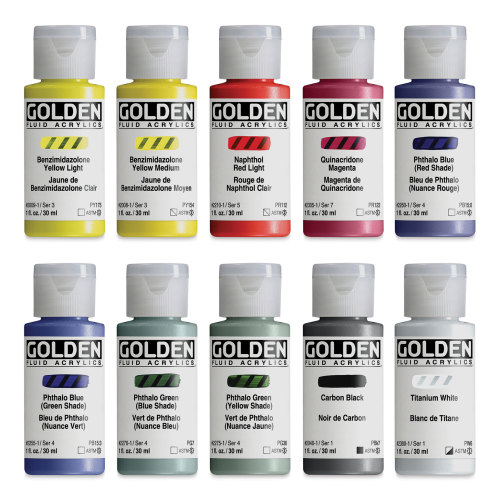
This brand is professional grade, highly pigmented, lightfast offers excellent coverage, and comes in a variety of vibrant colours perfect for creating unique works of art.
If you have ever used Golden before, you’ll know that their paints have high pigment density—their colours come from the bottle looking concentrated and bright. The experience of using these paints is unparalleled as they are made for professional artists. The paints have the texture of heavy cream, they dry to a unified surface finish that is flexible, UV resistant and will remain vibrant over time.
Because these colours are so concentrated, you only need around 10-15 drops of colour to add to the pouring medium in a ratio of around 1:3 parts paint to medium. The bottles come in four sizes, with 83 colours to choose from.
Arteza Pouring Paint
If you’re looking for a great value option, Arteza is the brand to check out. They offer numerous vivid colour options with concentrated pigment, so you can use less paint and get great coverage. The great thing about this paint brand is that the colours are premixed and ready to pour. So if you’d rather avoid the time spent mixing mediums, then this could be a great option.
The paints are non-toxic and safe to use. If you’re new to this medium, this set is perfect for trying various pour painting techniques with vibrant colours that won’t fade over time. They have a range of metallics and neon shades, so you can really experiment with your work.
These paints have an ideal viscosity and flow nicely when squeezed on the surface. They come in a smaller size of 60 ml and a medium size of 118 ml. The 60 ml bottles are perfect for pouring techniques used on smaller canvases, or for beginners who want to trial using different colours.
What colours do you need to create a pour painting?
The great thing about pour painting is that you can get creative and choose any colours you like! White and black usually act as base colours for pour painting art, so it may be useful to stock up on slightly larger bottles of white or black, depending on your desired effects.
Aside from all the bright and beautiful colours that are available to create pour paintings, many brands supply metallic, iridescent and pearlescent colours so you can create incredible effects. Look out for the interference and iridescent shades from Golden—these provide a unique finish with subtle shifts in colour that looks amazing!
Check out our comprehensive review of the best acrylic pouring paint to find a comparison of other artist grade brands.
Pour painting mediums
Pouring medium is essentially a mixture of water and an acrylic polymer, which helps to extend the paint so it flows easily from one area to another. It also provides flexibility to the dried painting by making it less fragile than if you used just acrylic paints. Some other mediums will create unique effects, like cells on the painting surface.
Liquitex Acrylic Pour Medium
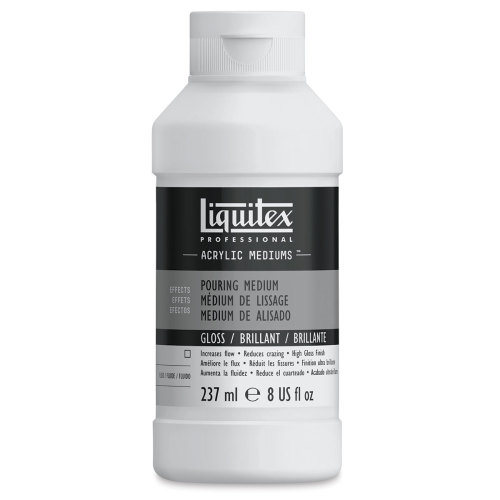
This pouring medium offers a smooth, glossy finish, with a flexible film resistant to yellowing, crazing, bubbling and cracking. It has great flow control enabling you to achieve even puddles of colour. It comes in both a gloss and a matte formula, the gloss formula creates wet look paintings, while the matte formula gives you a flat finish.
It’s very economical too—the 946ml bottle will last a really long time. The medium itself extends colours without affecting vibrancy or the stability of the paint film.
This medium is intermixable with all Liquitex products and it’s advised to use a ratio of 95% medium to 5% colour to get the best results.
Golden Pouring Medium
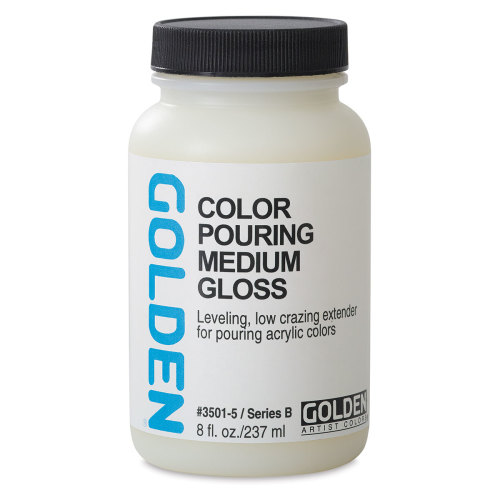
Golden Pouring Medium is an exceptional product that comes in both matte and gloss formula options. It’s available in different sizes ranging from 237 ml to 3.78 L, so you can choose to invest in a large bottle if you know you will be creating lots of fluid art! This medium is specially designed to extend colours without cracking or crazing, thus making it perfect for professional looking pours.
What sets this medium apart is that it improves adhesion, adds opacity, and levels colours, which results in a consistent and smooth finish. The colours hold their edges, so you can create intricate designs with ease.
The recommended ratio is to use 10 parts medium to 1 part colour, but it’s advisable to let the colour sit overnight to avoid air bubbles. Moreover, it’s compatible with Golden Acrylics, allowing you to achieve the desired result without compromising on the quality.
Floetrol
Floetrol is a popular pour painting medium known for being a reliable paint conditioner, which makes painted surfaces more uniform in texture and sheen.
Floetrol is also known to improve flow and self-leveling properties of paints, which makes it easier to distribute paints across surfaces evenly. When using Floetrol, we recommend using a 1:2 ratio of paint to the Floetrol. This mixture extends the drying time of the paint, preventing the paint from drying too quickly and resulting in an uneven finish.
Silicone oil
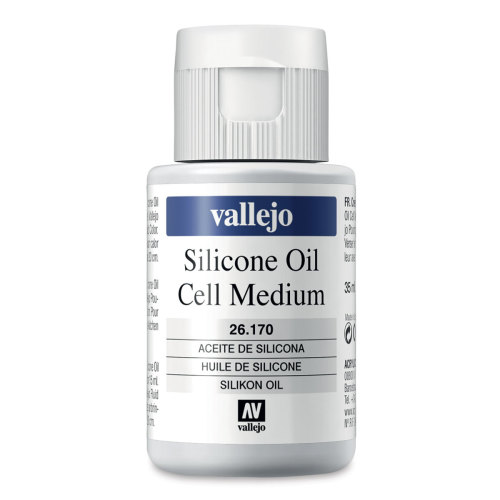
With silicone oil, you can make striking cell shapes with your pours. A few droplets of silicone oil will create striking patterns, that adds a new dimension to artwork.
Vallejo Silicone Oil Cell Medium is a great option for creating cells on paint pours, as this product creates smooth and even cell patterns that look unique and stunning.
Add a few drops to your colour of choice, pour onto the surface, then optionally use a heat gun to pop air bubbles that may have formed.
Pour Painting Surfaces
Selecting the surface you want to paint on is just as crucial as selecting the other pour painting supplies. There are lots of different surfaces you can choose, including many different brands of canvas and wooden panel. However, we recommend using a primed wood panel as it has a non-porous and sturdy surface, which allows the paint to spread evenly and retain its vibrancy.
Make sure to use a sealed and acrylic primed panel or canvas, to prevent the surface from absorbing the paint.
Blick Academic Cotton Stretched Canvas

This canvas is high quality, at a reasonable price! At the time of writing this review, the Blick canvas starts at just over $2.05, giving amazing value for those who are just starting out and want to experiment with pour painting supplies.
The canvas comes primed, so you don’t have to worry about applying gesso to the surface before use. You can hang the painting without needing to frame it, due to the fact that the canvas is stretched around stretcher bars.
Ampersand Value Series Artist Panels
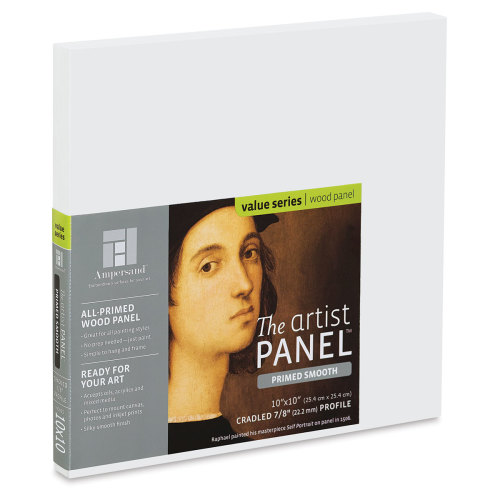
This is another incredible value yet high quality surface. The advantage of wooden panels over canvas, is that they don’t warp or sag like flexible canvases tend to do. They’re also more sturdy and resistant to moisture once they have been primed. Another great attribute is that the texture is completely smooth. The smooth texture naturally accentuates smaller details in the artwork.
Panels are a little heavier and a little more expensive compared to canvas, but they’re worth it for creating wonderful final pieces.
Pour Painting Tools
Lastly, you’ll need some pour painting tools to create unique designs and patterns. Tools like a heat gun or a blowtorch help to achieve the perfect finishes on your pour paintings. You can also use a silicone oil spray to create impressive cell patterns on your artwork— these patterns appear when the paint separates and creates small circular shapes.
Plastic cups and measuring sticks
Maybe the most essential tool to mix paint. Use cups for dirty pours and for flip cup pours. You can also use cups to mix individual colours, before pouring all the colours into a single cup.
Sealable plastic containers
Plastic cups with lids, or condiment bottles are great for keeping larger amounts of premixed paint sealed, to prevent colours from drying out if you want to use them again.
Heat gun
Heat guns are used to pop air bubbles that may have formed during the pour. Use the heat gun as soon as all the liquid is on the surface
The Makita Heat Gun is a great option for those just starting out in pour painting—it has a Push-button temperature control (122 – 1, 202°F). Use it on a low setting for pour painting, at around 150°F to 200°F. You will need a heat gun for using with silicone in order to create cells.
Palette knives
Palette knives are a great tool to use for spreading paint on the canvas. Once you have poured all your colours, you can manipulate the paint further by spreading out colours, or spreading the paint over the sides of the canvas.
Gloves
You’ll need to protect your hands when creating a pour painting—it can get messy! We recommend using latex or synthetic vinyl gloves, as they allow you to still have full mobility in your hands while protecting them from paint.
Surface cover
Use drop cloths to protect the floor and surfaces of the room you paint in. You can also use it to create a dust cover when the painting is drying.
Varnish

For finished works that you want to hang on the wall, a few coats of varnish will add extra protection from UV and dust. We recommend Liquitex Gloss varnish. It’s professional quality, enhances colours and protects colours in an artwork.

